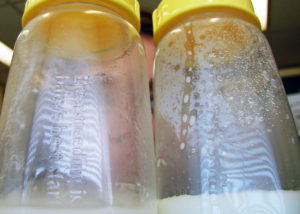Breastfeeding a Preterm Baby


Breastfeeding a Preterm Baby
What is Considered Premature?
Labor after 20 weeks and prior to 37 weeks is considered preterm.1 One in every ten babies is born premature.2 Further categories of prematurity are based on gestational age as listed below.3
– Less than 28 weeks = extremely preterm
– 28 weeks to 32 weeks = very preterm
– 32 weeks to 37 weeks = moderate to late preterm
Problems Associated With Premature Delivery
Understandably, the earlier a baby is born, the more likely he or she will have greater health complications. While two of the largest problems associated with prematurity deal with the baby’s brain and lungs, the rest of the body may also be affected. This includes the baby’s immune system, eyes, ears, intestines, and even issues with their teeth growth.4 These issues can be scary and parents customarily want to do anything and everything they can to best help their baby. One thing parents can do is to offer their baby human breast milk, “breastfeeding benefits preterm infants from a nutritional, gastrointestinal, immunological, developmental, and psychological perspective.”5
Why Breastfeed a Premature Baby?
*Information in this area is summarized from from the meta analysis, “A Review of the Literature Examining the Benefits and Challenges, Incidence and Duration, and Barriers to Breastfeeding in Preterm Infants”6
-
- Whey proteins from human milk are easier to digest and cause rapid gastric emptying, which is beneficial for the preterm infants’ gastrointestinal system.
- The hormones, peptides, amino acids, and glycoproteins may also assist mature the small intestine.
- Human breast milk contains a-lactalbumin, lactoferrin, lysozyme, and secretory immunoglobulin A, these aid to build the immunity of the baby giving “optimal immune defense.” These also aid in better digestion.
- Human breast milk contains lactose and oligosaccharides which are carbohydrates that aid in improving absorption of minerals and increase the beneficial bacteria in the intestines which help prevent against Necrotizing enterocolitis (NEC).
- Lipids in breast milk and the presence of bile salt-stimulated lipase allow the premature baby to absorb greater amounts of fat (as long as the milk is unprocessed).
- Human milk contains long-chain fatty acids that aid in cognition and vision growth.
- One study found that preterm infants fed human milk versus formula had a “reduction in the development of allergic symptoms.”
- Psychological benefit for the mother. Mothers report feelings of attachment, empowerment, and confidence when supplying their baby with their own breast milk.
- The breastfeeding mother produces sIgA antibodies when exposed to foreign antigens. The infant receives these antibodies through the breast milk creating a “passive immunity” to the baby’s immediate environment.
Premature Breast Milk vs. Mature Breast Milk
For the first couple of weeks, mothers of premature babies develop breast milk that is unique to meet their premature baby’s needs. The premature milk is higher in proteins, minerals including salt, and has fats that are easier to digest.7
Challenges Associated with Breastfeeding a Premature Baby
Although breastfeeding greatly benefits premature babies, there are specific challenges that affect a premature baby’s ability to breastfeed. The baby may not be physiologically stable to be at the mother’s breast and may only be able to be fed through a tube (gavage feedings). Later on when the infant is stable, breastfeeding may be difficult due to transitioning from gavage feedings to suckling on the breast. The mother may also have a difficult time creating and maintaining a milk supply for her preterm baby. Furthermore, dependent on the baby’s weight and gestation, the baby may need more nutrients in addition to the human breast milk.8 Even though human milk is recommended as the best milk for all infants including preterm, “no naturally occurring human milk can meet, without fortification, the increased nutrient requirements of very-low birth weight infants”9 A “very-low birth weight infant” includes any baby born less than 1.5kg or 3.13lbs.10
Tricks to Combat The Challenges of Breastfeeding a Premature Baby
Initiating Lactation (secretion of milk) through Pumping

If your baby is not physiologically stable, he or she will not be able to directly breastfeed and early initiation of breast pumping is vital. The breast pump should create a “milking action and not simply be a sucking device.” Pumping should be at regular intervals, aiming to pump “at least six to eight times a day.” Breast Pumping throughout the night is also needed, if breast fullness is noted upon awakening, you should pump more frequently, if trying to increase your milk supply. You should also not sleep for longer than four to five hours without pumping for at least the first couple of weeks.11
Maintaining a Milk Supply
Inadequate milk supply is the number one concern for mothers feeding their preterm infants. Breast milk supply runs by demand and due to the immaturity, weakness, and ineffectiveness of a preterm baby’s suck, the mother’s milk supply can be hindered. In one study, optimal milk production was associated with five or more milk expressions per day with pumping durations equaling more than 100 minutes per day!12
Quit Smoking
Breastfeeding is not contraindicated in cigarette smoking mothers.13 But, if you are smoking, please try to quit! Not only does second hand smoke harm your preterm baby, it also drastically decreases your breast milk supply.14 For help to quit smoking see, “4 Steps to Quit Smoking”.
Sequential Versus Simultaneous Breast Pumping
Pumping both breasts at the same time will cause you to express breast milk in a shorter amount of time as well as have an increase in prolactin levels.15 While two studies in 2001 have showed no change in the overall volume of milk produced,16 Jones states that their study published in 2001 “clearly shows that simultaneous pumping, with or without massage, is more effective than single pumping in producing an increased volume of milk.”17
Since then, a 2012 study has been published to support Jones. Although the study was only completed on mothers with term babies, their findings showed that simultaneous breast pumping is advantageous over sequential due an increase amount of milk in a shorter amount of time. They also found that simultaneous breast pumping produced milk with a higher cream content than sequential pumping thus giving baby more energy.18
Breast Massage
Breast massaging prior to pumping and during has shown to assist and increase your milk flow. To breast massage, gently use your fingertips to make circular motions starting at the outer edges of your breast working your way towards the nipple.
Kangaroo Care

When an unclothed baby is placed skin to skin with its mother (kangaroo care) it has shown to increase and sustain the mother’s milk supply and in return facilitates infant growth. Kangaroo care also assists the baby to be more comfortable at the breast a more competent breastfeeder. When your baby is stable to do kangaroo care, nurses in the neonatal intensive care unit (NICU) will assist you with this. Skin to skin care has also shown to help regulate the baby’s temperature, heart rate, and assist in the infant’s sleep organization. This is important because it helps to decrease your baby’s “energy expenditure.”19
Decrease Stress
Stress and fatigue have shown to have a decrease in milk production.20 Having a premature baby in NICU is extremely stressful and exhausting. Find a way to to manage your emotions if that is a daily walk outside, journaling, bath or channeling your spiritual side. Do what works for you.
Rooming In
Find out what your hospital offers regarding visiting hours in the NICU as well as “rooming in.” Moms who stay with their infants as much as possible have a greater milk supply, breastfeed longer, and are more likely to breastfeed exclusively.21
Food, Herbs, & Medications Used to Increase Milk Production
Galactogogues are substances that promote lactation. Many foods and herbs are used for these properties. Here is list from the article “Selection and Use of Galactogogues” that are commonly used:
Foods and Herbs with Galactogogue Properties
“alfalfa, almonds, anise, asparagus, barley, basil, beets, borage, caraway, carrots, chaste tree fruit, cherries, chicken broth/soup/stock, chickpeas (garbanzo beans), coconut, coriander seeds, cumin, dandelion, dill, fennel, fenugreek, flax seeds, garlic, ginger, goat’s rue, green beans, hibiscus, hops, lemon balm, lentils, lettuce, malunggay (moringa), marshmallow root, millet, molasses (black strap), mung, mushrooms, nettle, oat straw (oats), papaya, peas, pumpkin, quinoa seeds, red clover, red raspberry, rice, sage, seaweed soup, sesame seeds, spinach, sunflower seeds, sweet potatoes, thistles, turmeric, and vervain.”
Galactogogues Meidcaitions
Glactogogues medications may be used to increase a mother’s milk supply after non-pharmacologic interventions have been tried. The most common prescriptions include Domperidone, Metoclopramide, Metformin, and Oxytocin. Although, Food and Drug Administration (FDA) in 2004 issued a recommendation against the use of domperidone due to safety concerns.22
Non-Nutritive Sucking
Non-nutritive sucking assists the development of the baby’s ability to suck, it also increases the baby’s saliva that allows the baby to practice swallowing aiding in the digestion of the tube feedings.23
Goal Setting
One study published by The Journal of Human Lactation in 2015 showed that making a goal that is “time specific” increased the likelihood of the mother and baby to be breastfeeding at time of discharge. “The ultimate goal is for mothers to provide exclusive human milk feedings for the first 6 months of age, with continued human milk feeding along with other foods until at least 1 year of age.”24
Feed Directly at The Breast Before Utilizing The Bottle
Infants who receive their first “oral feeding” as direct breastfeeding versus bottle feeding are more likely to directly breastfeed more often and to be breastfeeding at discharge. Also, infants who are fed directly at the breast are shown to receive breast milk for longer versus babies who receive breastmilk from the bottle.25
Donor Milk
If you are not able to supply your preterm baby with enough or any breastmilk for multiple reasons, donor milk can be an adequate substitute. Both fresh and banked human milk have shown to have specific benefits for preterm infants. Similarly to your own fresh breast milk, donor milk may also need to be fortified if your baby has extra caloric needs. One study did find that donor milk has a slightly lower caloric value of 19kcal/oz versus the generally accepted caloric amount of fresh breast milk of 20kcal/oz. Very low birth weight infants are in need of approximately 120kcal a day. If you are interested, ask your neonatologist or nurses if donor milk is an option for you.26
Support
Practice breastfeeding while at the hospital utilizing a lactation consultant to best learn your baby’s feeding cues, holding techniques, and latching strategies.27 When women participate in a breastfeeding support group it has shown that they breastfeed for a longer duration. Ask your NICU nurses what support groups they can offer including WIC clinics, lactation consultants, breast-pump rentals, or even look in your local area for lay groups.
* Like any other article of mine, this information should not supersede or replace any information given to you by your own NICU nurses or neonatologist. I hope you find this helpful in an intense time and my heart is with you!
Resources:
1.“Preterm (Premature) Labor and Birth – ACOG.” http://www.acog.org/Patients/FAQs/Preterm-Premature-Labor-and-Birth.
2. “Long-term health effects of premature birth | March of Dimes.” http://www.marchofdimes.org/complications/long-term-health-effects-of-premature-birth.aspx.
3. “WHO | Preterm birth.” http://www.who.int/mediacentre/factsheets/fs363/en/.
4. “Long-term health effects of premature birth | March of Dimes.” http://www.marchofdimes.org/complications/long-term-health-effects-of-premature-birth.aspx.
5.“Literature Review – Breastfeeding Preterm Infants – Medscape.” http://www.medscape.com/viewarticle/502591.
6.“Literature Review – Breastfeeding Preterm Infants – Medscape.” http://www.medscape.com/viewarticle/502591.
7. “Providing Breastmilk for Premature and Ill … – HealthyChildren.org.” 21 Nov. 2015, https://www.healthychildren.org/English/ages-stages/baby/breastfeeding/Pages/Providing-Breastmilk-for-Premature-and-Ill-Newborns.aspx.
8. “Literature Review – Breastfeeding Preterm Infants – Medscape.” http://www.medscape.com/viewarticle/502591.
9. “Macronutrient Analysis of a Nationwide Sample of … – ScienceDirect.” http://www.sciencedirect.com/science/article/pii/S0002822308018853.
10.“WHO | Feeding of very-low-birth-weight infants.” 6 Jan. 2017, http://www.who.int/elena/titles/feeding_vlbw_infants/en/.
11.“Providing Breastmilk for Premature and Ill … – HealthyChildren.org.” 21 Nov. 2015, https://www.healthychildren.org/English/ages-stages/baby/breastfeeding/Pages/Providing-Breastmilk-for-Premature-and-Ill-Newborns.aspx.
12.“Literature Review – Breastfeeding Preterm Infants – Medscape.” http://www.medscape.com/viewarticle/502591.
13.“Breastfeeding and the Use of Human Milk ….” http://pediatrics.aappublications.org/content/115/2/496.
14.“LLLI | FAQ on Smoking and Breastfeeding – La Leche League.” 12 Nov. 2008, http://www.lalecheleague.org/faq/smoking.html.
15.“Literature Review – Breastfeeding Preterm Infants – Medscape.” http://www.medscape.com/viewarticle/502591.
16.“Literature Review – Breastfeeding Preterm Infants – Medscape.” http://www.medscape.com/viewarticle/502591.
17.“A randomised controlled trial to compare methods of milk expression ….” http://pubmedcentralcanada.ca/pmcc/articles/PMC1721311/pdf/v085p00F91.pdf.
18. DK, Prime, Garbin CP, Hartmann PE, and Kent JC. “Simultaneous Breast Expression in Breastfeeding Women Is More Efficacious than Sequential Breast Expression.”Breastfeeding Medicine : The Official Journal of the Academy of Breastfeeding Medicine. Mary Ann Liebert Inc., 6 Nov. 2012. Web.
19. Cartwright, Joanna, Teresa Atz, Susan Newman, Martina Mueller, and Jill Radtke Demirci. “An Integrative Review of Interventions to Promote Breastfeeding in the Late Preterm Infant.”Journal of Obstetric, Gynecologic & Neonatal Nursing (2017): Web.
20. “Literature Review – Breastfeeding Preterm Infants – Medscape.” http://www.medscape.com/viewarticle/502591.
21. Cartwright, Joanna, Teresa Atz, Susan Newman, Martina Mueller, and Jill Radtke Demirci. “An Integrative Review of Interventions to Promote Breastfeeding in the Late Preterm Infant.”Journal of Obstetric, Gynecologic & Neonatal Nursing (2017): Web.
22. Nice, Frank J., BS, MS, MPA, DPA. “Selection and Use of Galactogogues.” ICAN, Aug. 2015. Web.
23.”Literature Review – Breastfeeding Preterm Infants – Medscape.” http://www.medscape.com/viewarticle/502591.
24. Briere, Carrie-Ellen, Jacqueline M. Mcgrath, Xiaomei Cong, Elizabeth Brownell, and Regina Cusson. “Direct-Breastfeeding Premature Infants in the Neonatal Intensive Care Unit.”Journal of Human Lactation 31.3 (2015): 386-92. Web.
25.”Macronutrient Analysis of a Nationwide Sample of … – ScienceDirect.” http://www.sciencedirect.com/science/article/pii/S0002822308018853.
26.Briere, Carrie-Ellen, Jacqueline M. Mcgrath, Xiaomei Cong, Elizabeth Brownell, and Regina Cusson. “Direct-Breastfeeding Premature Infants in the Neonatal Intensive Care Unit.”Journal of Human Lactation 31.3 (2015): 386-92. Web.
27.Briere, Carrie-Ellen, Jacqueline M. Mcgrath, Xiaomei Cong, Elizabeth Brownell, and Regina Cusson. “Direct-Breastfeeding Premature Infants in the Neonatal Intensive Care Unit.”Journal of Human Lactation 31.3 (2015): 386-92. Web.